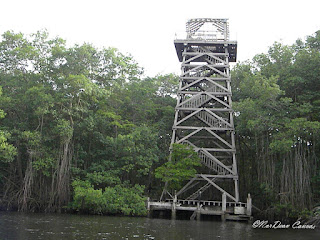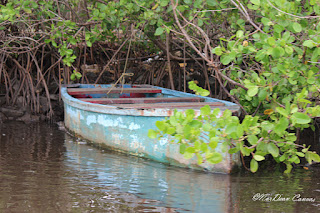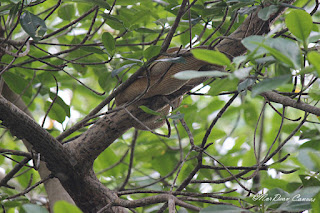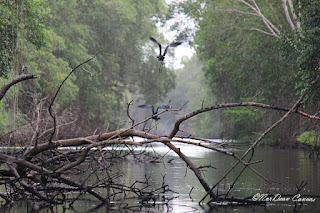Corpus
Christi – The day of planting, and the beginning of a glorious long
weekend.
Our plans were to go to the
bird sanctuary which is housed on the Caroni River and is the nesting ground
for one of the national birds of Trinidad and Tobago, the Scarlet Ibis (Eudocimus Ruber). We arrived at Caroni and were astonished to
see that the tour boat was just a huge version of a pirogue with rows of seats
installed for tours. The boats were
loaded to maximum capacity each holding at least forty (40) people. When it was our turn we were helped into the
boat row by row by men working for the ‘tour’ group, the seats were padded as
we were going to be on the river for at least two and a half hours. We started downstream; the water was brown
and murky with no scent (praise God). On our way up the highway we passed a Caiman
which was hit by a vehicle and dead on the side of the road, missing its tail
(can someone say road kill). Apparently,
the tail is the most popular part for eating, and I say apparently because I have
never eaten it and have no plans of doing so.
That being said, I was on the lookout for these alligator species in the
murky waters of the river. I had an end
seat, and as such, thought or envisioned a Caiman rearing its ugly head right at
the edge of this dingy boat, and right at me.
Very luckily, I never saw one. Our
tour guide took us up and down many tributaries, along the way describing the
tiny crabs that we saw, the oysters along the barks of the mangrove roots, the
different types of mangrove trees we saw and the snakes that were wrapped in
the forks of the tree branches. We also
saw blue herons, white egrets, a long neck egret (great egret) and alas the red
scarlet ibis (Eudocimus
rubber). We parked in a wide open area facing the
embankment of a peninsula where the white egret and scarlet ibis birds would
come in for the night, to mate and nest. There were so
many birds in the trees of the embankment by six (6) pm that they looked like
roses in the trees. The scarlet ibis are
afraid of the boats and thus stay and fly far from any boat that they see. The Peregrine Falcon is the scarlet ibis’
predator. It was a very beautiful site.
A little history
:- The Caroni Swamp is an estuarine system comprising 5,611 hectors of mangrove
forest and herbaceous marsh, interrupted by numerous channels, and brackish and
saline lagoons, and with extensive intertidal mudflats on the seaward
side. This swamp is an important wetland
since it is ecologically diverse, consisting of marshes, mangrove swamp and
tidal mudflats in close proximity. The wetland
provides a variety of habitats for flora and faunal species and as such,
supports a rich biodiversity. It is a highly productive system that provides
food and protection and is a nursery for marine and freshwater species. Red, black and white mangroves are present
throughout Caroni, the red being very important for shoreline stabilization and
flood control.
There
are over a hundred different species of birds, caimans, snakes, crabs, herons,
iguanas, mudskippers, oysters and fauna that inhabit the Caroni Swamp.
Enjoy
a visual depiction of the area below.
-Nordean Canvas
 |
| Mangrove along the river |
 |
| More Mangrove |
 |
| A river's view of the mangrove |
 |
| Old tower, they used to allow climbing but its now delapidated |
 |
| One of the tributaries opening into a lakes view |
|
 |
| Notice the calmness of the water here |
|
 |
| Another boat ahead of us in the beginning of the journey |
 |
| Small crabs |
|
 |
| Mangrove fauna |
|
 |
| The roots of the mangrove |
 |
| Marooned! |
|
 |
| Oysters |
 |
| Along the river/swamp |
 |
| Fauna view along the river |
 |
| In the marsh |
 |
| So sticky |
 |
| The roots |
 |
| A different type of crab with spider like features |
 |
| Climb crab climb |
 |
| So serene |
 |
| More serenity |
 |
| It's brighter around this corner |
 |
| Snake yikes |
 |
| Snake is not moving at all |
 |
| Different growth on this bark |
 |
| Herons flying low |
 |
| Blue heron leading the way |
|
 |
| So close yet so far |
 |
| Up in the tree |
 |
| Perch heron perch |
 |
| The seeds of the tree, these fall into the river, float down stream and new trees are born |
 |
| Another tributary |
 |
| Another tower view |
 |
| Murky and slippery looking, somewhere there is a caiman |
 |
| Wide lake opening |
 |
| Other side of said lake |
 |
| Another group chugging along |
 |
| The lighting has changed |
 |
| Long neck egret |
 |
| Low tide, the long neck egret is walking |
 |
| A white egret |
 |
| Willet |
 |
| The sun is going down |
 |
| Egrets starting to nest |
 |
| Here comes the scarlet ibis |
 |
| Scarlet ibis coming in from Venezuela |
 |
| They're starting to dot the mangrove |
 |
| Scarlet Ibis will remain on the branches while egrets will go under the mangrove |
|
 |
| In flight |
 |
| Egret |
 |
| In numbers |
 |
| Here the come |
 |
| The trees are starting to look like rose bushes |
 |
| Red red red |
 |
| Droves |
 |
| Come and nest |
 |
| Another tour boat with only Asians |
 |
| The evening sky |
© 2013, Odette M. Lawrence and NorDean Canvas. All rights reserved. The use and/or
duplication of this material without the express and written permission
of this blog’s author and/or owner are unauthorized and strictly
prohibited.































































































